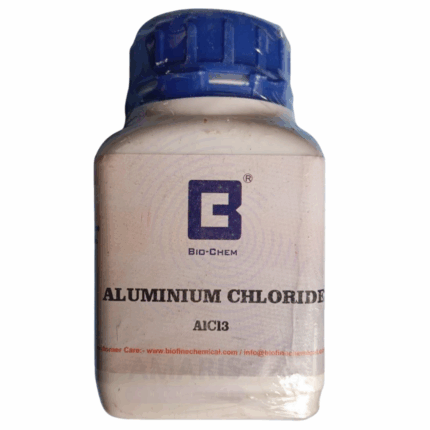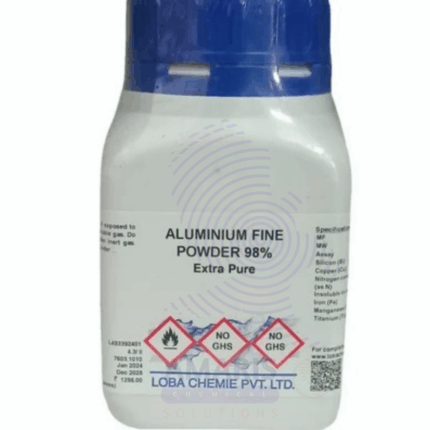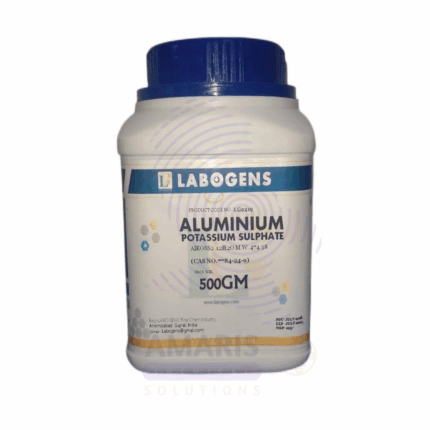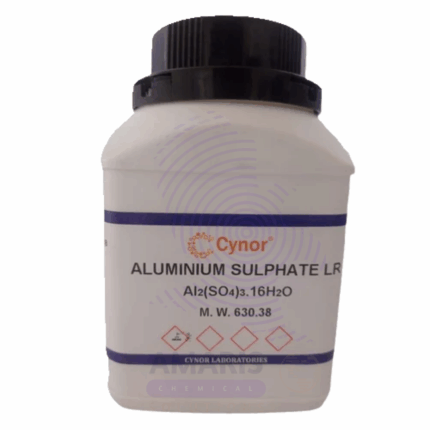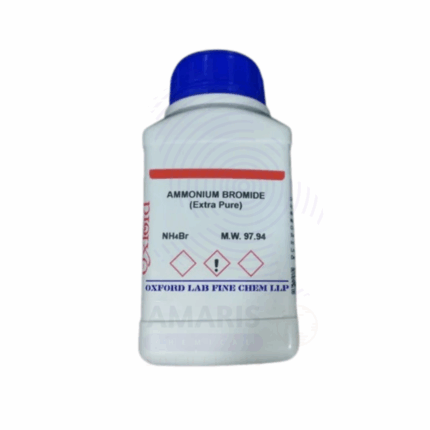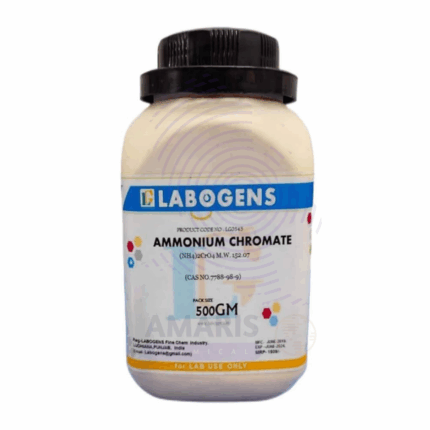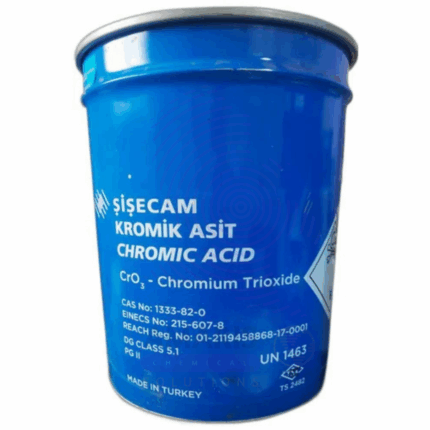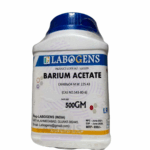
Barium Carbonate Extra Pure
$ 18.00 Original price was: $ 18.00.$ 17.78Current price is: $ 17.78.
Barium Carbonate Extra Pure is a high-purity, white, odorless powder commonly used in laboratory settings for analytical, inorganic, and materials chemistry. It serves as a key reagent in qualitative analysis for detecting and precipitating sulfate ions, as well as a precursor in the synthesis of other barium compounds. Its low solubility in water but reactivity with acids makes it valuable in controlled reaction studies and carbonate system investigations. The extra pure grade ensures minimal contamination, making it suitable for high-precision research and educational experiments. It should be handled with care and stored in a tightly sealed container in a cool, dry place, as barium compounds are toxic if ingested or inhaled.
Barium Carbonate Extra Pure
Primary Uses
- Reagent for Acid Neutralization and Gas Generation
- Reacts with dilute acids (e.g., HCl) to release carbon dioxide gas (CO₂) — used in gas evolution demonstrations and stoichiometric calculations.
- Precursor in the Preparation of Other Barium Salts
- Used to synthesize barium nitrate, chloride, acetate, and other soluble barium compounds through acid-base reactions.
- Qualitative Test for Acid Radicals (Carbonates Group)
- Serves as a representative Group I anion salt in qualitative analysis, especially for observing effervescence and gas tests.
- Model Compound in Solubility Product (Ksp) and Equilibrium Studies
- Demonstrates principles of low-solubility salts, common ion effect, and precipitation equilibria.
- Component in Laboratory-Scale Ceramic and Material Research
- Used in forming barium-containing glass, ceramics, or ferrites, especially in advanced inorganic or solid-state chemistry experiments.
Secondary Uses
- Ion-Exchange and Water Softening Studies
- Can be used to simulate precipitation of hardness ions (e.g., sulfate) in environmental chemistry labs.
- Starting Material in Crystal Growth and Solid-State Synthesis
- Acts as a Ba²⁺ source for growing single crystals or solid-state compounds such as BaTiO₃, BaFe₁₂O₁₉, etc.
- Research on Thermal Decomposition and Calcination
- Studied in thermal analysis (TGA/DSC) for carbonate stability, decomposition to BaO, and CO₂ release profiles.
- Flame Coloration in Demonstrations
- Although less common than soluble barium salts, can be used in green flame tests when converted to volatile forms.
- Environmental Chemistry Simulations
- Applied in simulating mineral precipitation or soil ion interaction experiments in geochemistry research.
| PACK SIZE |
500 grams Plastic Tin |
|---|
1. Basic Identification Attributes
- Chemical Name: Barium Carbonate
- CAS Number: 513-77-9
- HS Code: 28366000 (Barium carbonate)
- Molecular Formula: BaCO₃
- Synonyms:
- Carbonic acid, barium salt
- Witherite (mineral form)
- Barium monocarbonate
2. Physical & Chemical Properties
- Physical State: Solid (fine powder or granules)
- Color & Odor: White to off-white; odorless
- Boiling Point: Decomposes before boiling
- Melting Point: ~811 °C (decomposes to BaO and CO₂)
- Density/Specific Gravity: ~4.29 g/cm³
- Solubility:
- Water: Practically insoluble (~0.002 g/100 mL at 20 °C)
- Acids: Soluble with effervescence (CO₂ release)
- pH Level: Slightly alkaline suspension
- Vapor Pressure: Not applicable (non-volatile)
- Flash Point: Not flammable
- Autoignition Temperature: Not applicable
- Viscosity: Not applicable
3. Safety & Hazard Attributes
- Hazard Class (GHS):
- Acute Toxicity – Oral (Category 3)
- Harmful if ingested; may affect nervous and muscular systems
- NFPA Ratings:
- Health: 2
- Flammability: 0
- Reactivity: 0
- Exposure Limits:
- OSHA PEL (as soluble barium compounds): 0.5 mg/m³ (as Ba)
- ACGIH TLV: 0.5 mg/m³ (as Ba)
- Reactivity:
- Stable in dry air
- Reacts with acids to release carbon dioxide and soluble barium
4. Storage & Handling Attributes
- Storage Conditions:
- Store in a cool, dry, well-ventilated area
- Keep container tightly closed
- Incompatible Materials:
- Strong acids (forms toxic soluble barium salts)
- Moisture (can promote slow reactivity)
- Container Type:
- Airtight plastic or glass containers
- Shelf Life & Expiration Date:
- ~3 years if kept sealed and dry
- Special Handling Requirements:
- Use gloves, lab coat, and dust mask
- Avoid ingestion or inhalation of dust
5. Regulatory & Compliance Attributes
- Regulatory Status:
- Listed under TSCA, REACH
- Toxic substance – requires safe handling
- Transportation Restrictions:
- Not classified as hazardous for transport
- Waste Disposal Method:
- Dispose as hazardous waste
- Never dispose down the drain
6. Environmental & Health Impact
- Ecotoxicity:
- Very toxic to aquatic life if converted to soluble barium in environment
- Persistence in Environment:
- Inert in soil; low mobility due to low solubility
- Carcinogenicity/Mutagenicity:
- Not classified as carcinogenic
- Biodegradability:
- Inorganic; not biodegradable
SAFETY PRECAUTIONS
- Personal Protective Equipment (PPE):
- Wear a lab coat, chemical-resistant gloves (nitrile), and safety goggles.
- Use a dust mask or work inside a fume hood to avoid inhaling fine powders.
- Handling:
- Avoid inhalation, ingestion, and contact with eyes or skin.
- Handle powder gently to prevent airborne particles.
- Do not mix with acids—reacts to release toxic carbon dioxide and soluble barium ions.
- Storage:
- Store in a cool, dry, well-ventilated area.
- Keep container tightly sealed and away from acids and moisture.
- Clearly label container as Toxic.
- Hygiene Measures:
- Wash hands and face thoroughly after handling.
- Clean up spills with care to avoid dust generation.
- Never eat, drink, or smoke in work areas.
FIRST AID MEASURES
- Inhalation:
- Remove person to fresh air immediately.
- If breathing is difficult, provide oxygen.
- Seek immediate medical attention—dust is toxic when inhaled.
- Skin Contact:
- Wash affected areas with soap and plenty of water.
- Remove contaminated clothing.
- Seek medical advice if irritation or absorption symptoms occur.
- Eye Contact:
- Flush eyes with plenty of water for at least 15 minutes, lifting eyelids occasionally.
- Seek immediate medical attention—can cause corneal irritation.
- Ingestion:
- Do NOT induce vomiting.
- Rinse mouth with water.
- Give water or milk only if the person is fully conscious.
- Seek emergency medical treatment—barium carbonate is highly toxic and can cause:
- Severe muscle weakness
- Vomiting, diarrhea
- Convulsions
- Cardiac arrhythmias
- Hypokalemia
FIRE FIGHTING MEASURES
- Suitable Extinguishing Media:
- Use dry chemical, CO₂, or foam depending on surrounding materials.
- Water may be used cautiously to cool unaffected containers.
- Specific Hazards:
- Non-flammable, but decomposes when heated to release:
- Carbon dioxide (CO₂)
- Toxic barium oxide (BaO) fumes
- Non-flammable, but decomposes when heated to release:
- Protective Equipment:
- Firefighters must wear SCBA (self-contained breathing apparatus) and full protective gear.
- Firefighting Instructions:
- Approach fire from upwind.
- Avoid breathing dust or combustion byproducts.
- Prevent runoff—toxic to aquatic life and soils.


 Preservatives(food)
Preservatives(food) Flavor Enhancers
Flavor Enhancers Acidulants
Acidulants Sweeteners
Sweeteners Antioxidants
Antioxidants Colorants(food)
Colorants(food) Nutraceutical Ingredients (food)
Nutraceutical Ingredients (food) Nutrient Supplements
Nutrient Supplements Emulsifiers
Emulsifiers
 Collectors
Collectors Dust Suppressants
Dust Suppressants Explosives and Blasting Agents
Explosives and Blasting Agents Flocculants and Coagulants
Flocculants and Coagulants Frothers
Frothers Leaching Agents
Leaching Agents pH Modifiers
pH Modifiers Precious Metal Extraction Agents
Precious Metal Extraction Agents
 Antioxidants(plastic)
Antioxidants(plastic) Colorants (Pigments, Dyes)
Colorants (Pigments, Dyes) Fillers and Reinforcements
Fillers and Reinforcements Flame Retardants
Flame Retardants Monomers
Monomers Plasticizers
Plasticizers Polymerization Initiators
Polymerization Initiators Stabilizers (UV, Heat)
Stabilizers (UV, Heat)
 Antifoaming Agents
Antifoaming Agents Chelating Agents
Chelating Agents Coagulants and Flocculants
Coagulants and Flocculants Corrosion Inhibitors
Corrosion Inhibitors Disinfectants and Biocides
Disinfectants and Biocides Oxidizing Agents
Oxidizing Agents pH Adjusters
pH Adjusters Scale Inhibitors( water)
Scale Inhibitors( water)
 Antioxidants(cosmetic)
Antioxidants(cosmetic) Emollients
Emollients Fragrances and Essential Oils
Fragrances and Essential Oils Humectants
Humectants Preservatives
Preservatives Surfactants(cosmetic)
Surfactants(cosmetic) Thickeners
Thickeners UV Filters
UV Filters
 Fertilizers
Fertilizers Soil Conditioners
Soil Conditioners Plant Growth Regulators
Plant Growth Regulators Animal Feed Additives
Animal Feed Additives Biostimulants
Biostimulants Pesticides (Herbicides, Insecticides, Fungicides)
Pesticides (Herbicides, Insecticides, Fungicides)
 Active Pharmaceutical Ingredients (APIs)
Active Pharmaceutical Ingredients (APIs) Excipients
Excipients Solvents(pharmaceutical)
Solvents(pharmaceutical) Antibiotics
Antibiotics Antiseptics and Disinfectants
Antiseptics and Disinfectants Vaccine Adjuvants
Vaccine Adjuvants Nutraceutical Ingredients (pharmaceutical)
Nutraceutical Ingredients (pharmaceutical) Analgesics & Antipyretics
Analgesics & Antipyretics
 Analytical Reagents
Analytical Reagents Solvents(lab)
Solvents(lab) Chromatography Chemicals
Chromatography Chemicals Spectroscopy Reagents
Spectroscopy Reagents microbiology-and-cell-culture-reagents
microbiology-and-cell-culture-reagents Molecular Biology Reagents
Molecular Biology Reagents Biochemical Reagents
Biochemical Reagents Inorganic and Organic Standards
Inorganic and Organic Standards Laboratory Safety Chemicals
Laboratory Safety Chemicals Specialty Laboratory Chemicals(Special Laboratory Equipment)
Specialty Laboratory Chemicals(Special Laboratory Equipment)
 Demulsifiers
Demulsifiers Hydraulic Fracturing Fluids
Hydraulic Fracturing Fluids Scale Inhibitors(oil)
Scale Inhibitors(oil) Surfactants(oil)
Surfactants(oil) Drilling Fluids
Drilling Fluids
 Dyes and Pigments
Dyes and Pigments Bleaching Agents
Bleaching Agents Softening Agents
Softening Agents Finishing Agents
Finishing Agents Antistatic Agents
Antistatic Agents
 Admixtures
Admixtures Waterproofing Agents
Waterproofing Agents Sealants and Adhesives
Sealants and Adhesives Curing Compounds
Curing Compounds Concrete Repair Chemicals
Concrete Repair Chemicals Anti-Corrosion Coatings
Anti-Corrosion Coatings
 Surfactants(cleaning)
Surfactants(cleaning) Builders
Builders Enzymes
Enzymes Solvents (Cleaning)
Solvents (Cleaning) Fragrances
Fragrances
 Electronic Chemicals
Electronic Chemicals Catalysts
Catalysts Lubricants
Lubricants Photographic Chemicals
Photographic Chemicals Refrigerants
Refrigerants Automotive chemicals
Automotive chemicals Pyrotechnic Chemicals
Pyrotechnic Chemicals
 Biodegradable Surfactants
Biodegradable Surfactants Bio-based Solvents
Bio-based Solvents Renewable Polymers
Renewable Polymers Carbon Capture Chemicals
Carbon Capture Chemicals Wastewater Treatment Chemicals
Wastewater Treatment Chemicals
 Pigments
Pigments Solvents(paint)
Solvents(paint) Specialty Coatings
Specialty Coatings Binders/Resins
Binders/Resins Additives
Additives Driers
Driers Anti-Corrosion Agents
Anti-Corrosion Agents Functional Coatings
Functional Coatings Application-Specific Coatings
Application-Specific Coatings
 Fresh Herbs
Fresh Herbs Ground Spices
Ground Spices Whole Spices
Whole Spices Spice Blends
Spice Blends Dried Herbs
Dried Herbs
 Leavening Agents
Leavening Agents Dough Conditioners
Dough Conditioners Flour Treatments
Flour Treatments Fat Replacers
Fat Replacers Decoratives
Decoratives Preservatives(baking)
Preservatives(baking)
 Plasticizers & Softeners
Plasticizers & Softeners Reinforcing Agents
Reinforcing Agents Adhesion Promoters
Adhesion Promoters Vulcanizing Agents
Vulcanizing Agents Antidegradants
Antidegradants Blowing Agents
Blowing Agents Fillers & Extenders
Fillers & Extenders Accelerators & Retarders
Accelerators & Retarders


